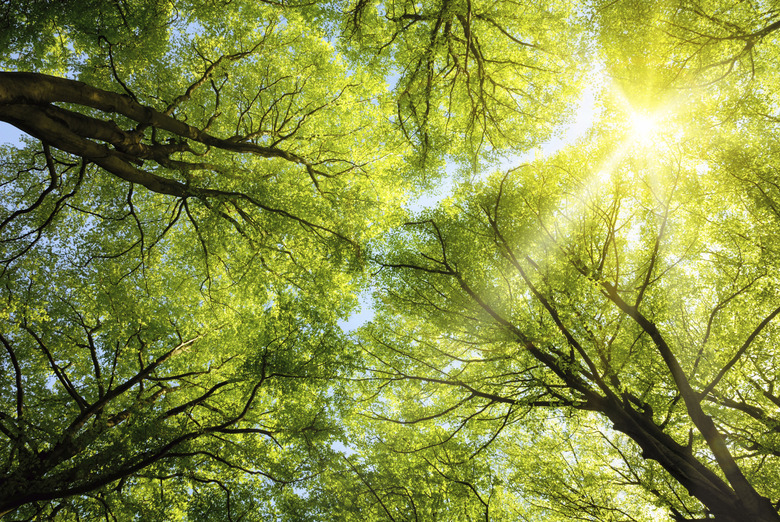How To Tell A Female Tree From A Male Tree
The terms "male" and "female," when used to describe trees, fit as awkwardly as someone else's shoes. Although the flowers of flowering trees (the angiosperms) and the cones of conifers (the most prominent of the gymnosperms) need to be fertilized with pollen to produce fruit, the breakdown of plant sexuality is less rigid than that traditionally described in humans and most animals. Some trees produce only male or only female flowers, while others bear both male and female flowers. Reproductive features such as flowers, fruits and cones may in some cases help you identify the "sex" of a tree.
Female Flowers and Male Flowers
Female Flowers and Male Flowers
The flowers that trees bear either function as female or male. Female flowers contain ovaries that develop into fruit, while male flowers bear pollen that fertilizes the female flowers. Some trees bear flowers of only one sex; those trees are sometimes called male or female.
Many trees, however, bear flowers of both sexes. The terms used to describe trees are dioecious, which refers to a tree that has either male or female flowers, and monoecious, which describes a tree that has both male and female flowers.
Dioecious Distinctions
Dioecious Distinctions
If a kind of tree is dioecious, then distinguishing a male tree from a female tree is a matter of watching the trees carefully. Male trees have male flowers, which produce pollen. Female trees have female flowers that produce fruit.
Many kinds of backyard trees are dioecious; they include white ash (Fraxinus americana), which is hardy in United States Department of Agriculture plant hardiness zones 3 through 9, ginkgo (Ginkgo biloba, USDA zones 4 through 9), and boxelder (Acer negundo, USDA zones 2 through 10). If you are allergic to pollen and a tree makes you sneeze, it is a male.
Secondary Sexual Features
Secondary Sexual Features
Once you have established that a tree species is dioecious, look for other distinctions between males and females of the species. For example, the common persimmon tree (Diospyros virginiana, USDA zones 6 through 10) is dioecious; male persimmon trees have small flowers in clusters while females have large, single blossoms.
The tips of male flowers on the cedar of Lebanon (Cedrus libani, USDA zones 6 through 9) look dirty during pollen season. Researchers at Weill Cornell Medical College in Qatar learned to identify male and female date trees by their genetic differences, which is extremely useful because date trees are difficult to tell apart before they fruit. The pygmy date palm tree (Phoenix roebelenii) is hardy in USDA zones 10 through 11.
Monoecious Characteristics
Monoecious Characteristics
Eastern white pine (Pinus strobus, USDA zones 3 through 8) is an example of a monoecious tree; pines and other members of the pine family, like most conifers, are monoecious. A pine tree can produce pine cones without another member of its species nearby.
It is not optimal for a tree to fertilize itself, though. Monoecious trees have different methods of discouraging self-fertilization. Those methods include physical separation, with the female flowers on top of the trees and male flowers below.
Members of the birch family – including the birches themselves as well as alders, hazels and hop-hornbeams – are prominent examples of monoecious broadleaf trees. They produce male and female flowers in catkin form on the same tree, the male catkins being long and prominent; fruiting catkins often have a conelike appearance, as in alders and hop-hornbeams.
Complex Sex
Complex Sex
Tree sexual reproduction is much more nuanced, however. Some trees have flowers that contain both male and female parts, and some flowers have sexual parts that don't function or that function only occasionally. Likewise, some trees change sex from season to season while others change once or twice during their lifetime. In short, tree gender is a complex and ever-evolving phenomenon that biologists continue to study.
References
- Lady Bird Johnson Wildflower Center: Identifying Gender of Persimmon Trees
- Geary County, Kansas, Extension Office: Seasonal Changes in Appearance of Cedar Trees
- Cornell University, Cornell Chronicle: WCMC-Q Researchers Discover Key for Identifying Gender in Date Palm Trees
- Missouri Botanical Garden: Fraxinus Americana
- Floridata: Ginkgo Biloba
- Missouri Botanical Garden: Acer Negundo
- Floridata: Cedrus Libani
Cite This Article
MLA
Spengler, Teo. "How To Tell A Female Tree From A Male Tree" sciencing.com, https://www.sciencing.com/how-to-tell-a-female-tree-from-a-male-tree-12377156/. 30 September 2021.
APA
Spengler, Teo. (2021, September 30). How To Tell A Female Tree From A Male Tree. sciencing.com. Retrieved from https://www.sciencing.com/how-to-tell-a-female-tree-from-a-male-tree-12377156/
Chicago
Spengler, Teo. How To Tell A Female Tree From A Male Tree last modified March 24, 2022. https://www.sciencing.com/how-to-tell-a-female-tree-from-a-male-tree-12377156/
